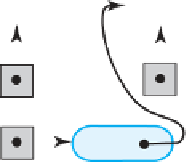Java Reference
In-Depth Information
Let
nodeBefore
reference the node that will be before the new node
Set
nodeAfter
to
nodeBefore
's link
Set
newNode
's link to
nodeAfter
Set
nodeBefore
's link to
newNode
To indicate where in the chain the new node should be inserted, let's number the nodes, begin-
ning with 1. We need to locate the node at a given position within the chain and get a reference to it.
Suppose that the method
getNodeAt
performs this task for us. Since the method returns a reference
to a node, and the class
Node
will be an inner class of a class of lists,
getNodeAt
is an implementa-
tion detail that we would not want a client to use. Thus,
getNodeAt
should be a private method.
Let's specify
getNodeAt
as follows:
// Returns a reference to the node at a given position.
// Precondition: The chain is not empty;
// 1 <= givenPosition <= numberOfNodes
private
Node getNodeAt(
int
givenPosition)
We can define the method later.
In the meantime, knowing only what
getNodeAt
does, and not how it does it, we can use it in
the implementation of the previous pseudocode. If
newPosition
is the number of the new node
after its insertion, the following Java statements add the new node to the chain:
Node newNode =
new
Node(newEntry);
Node nodeBefore = getNodeAt(newPosition - 1);
Node nodeAfter = nodeBefore.getNextNode();
newNode.setNextNode(nodeAfter);
nodeBefore.setNextNode(newNode);
Figure 14-3a shows the chain after the first three statements execute, and Figure 14-3b shows
it after the node has been added. In this figure,
newPosition
is 3.
FIGURE 14-3
A chain of nodes (a) just prior to adding a node between two adjacent nodes;
(b) just after adding a node between two adjacent nodes
(a)
firstNode
nodeBefore
nodeAfter
newNode
(b)
firstNode
nodeBefore
nodeAfter
newNode

































